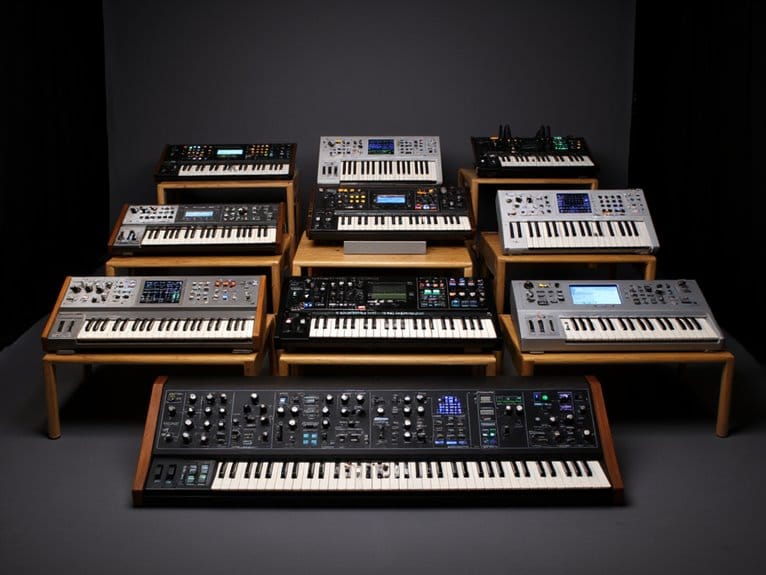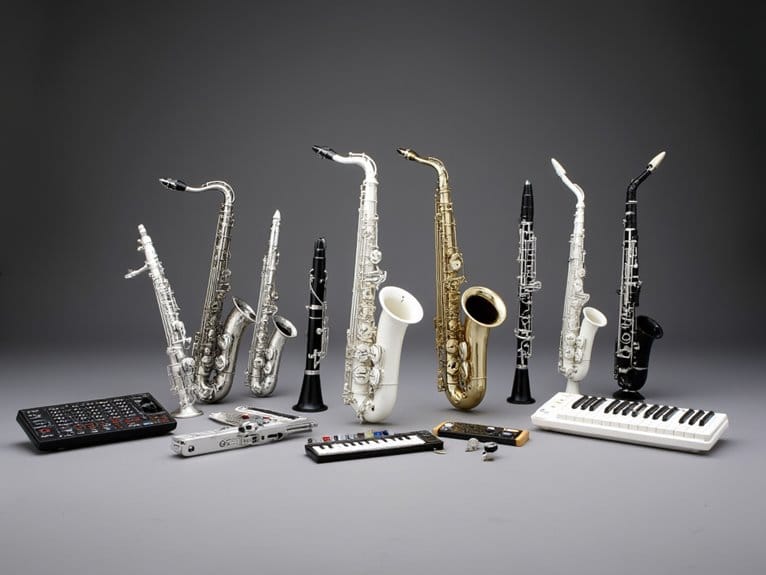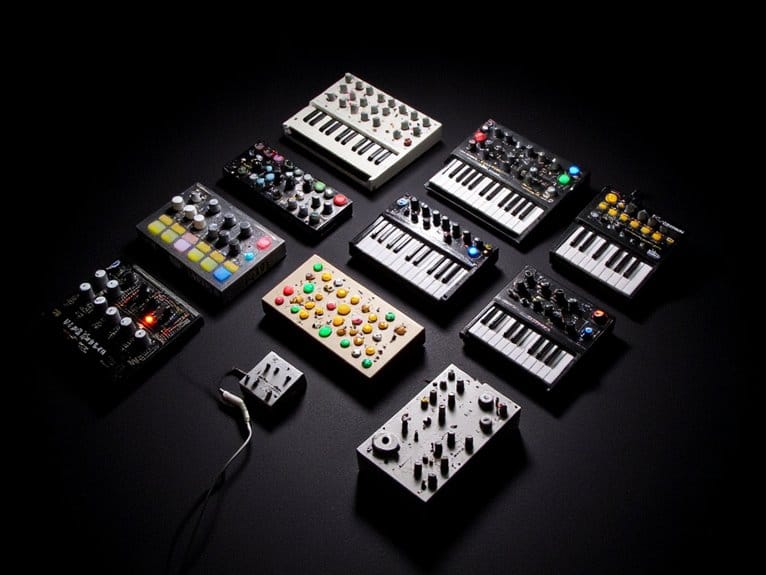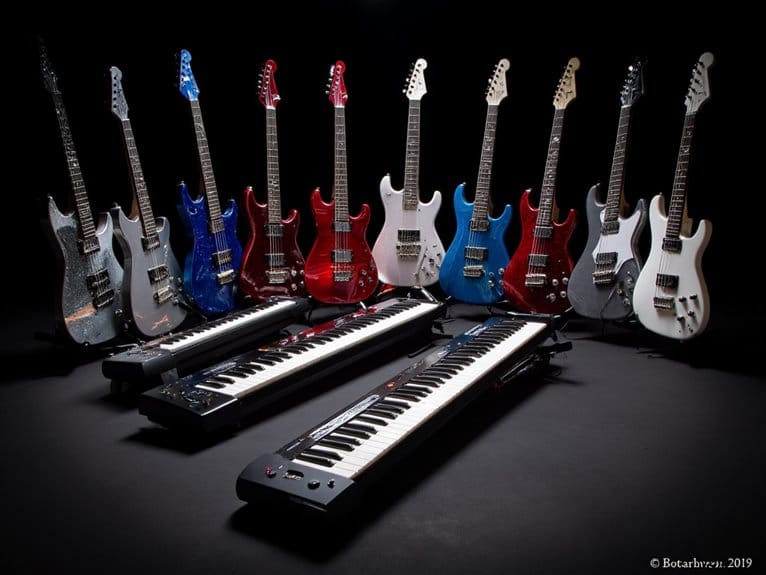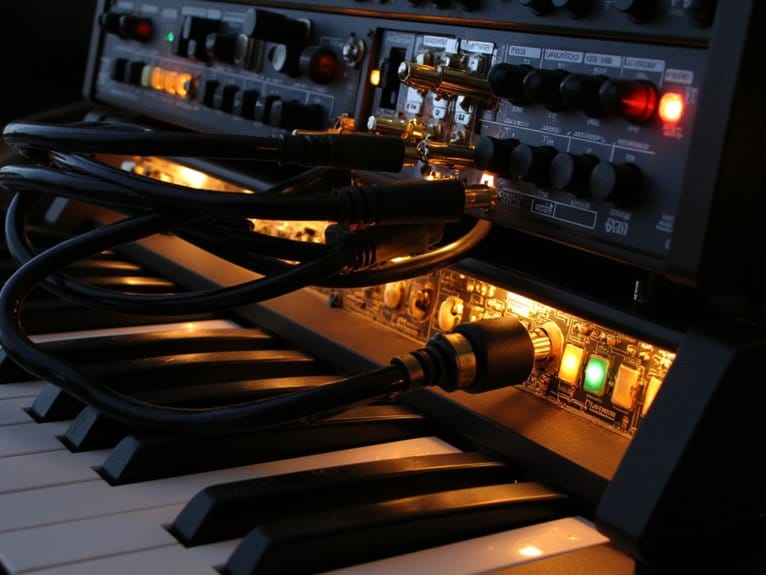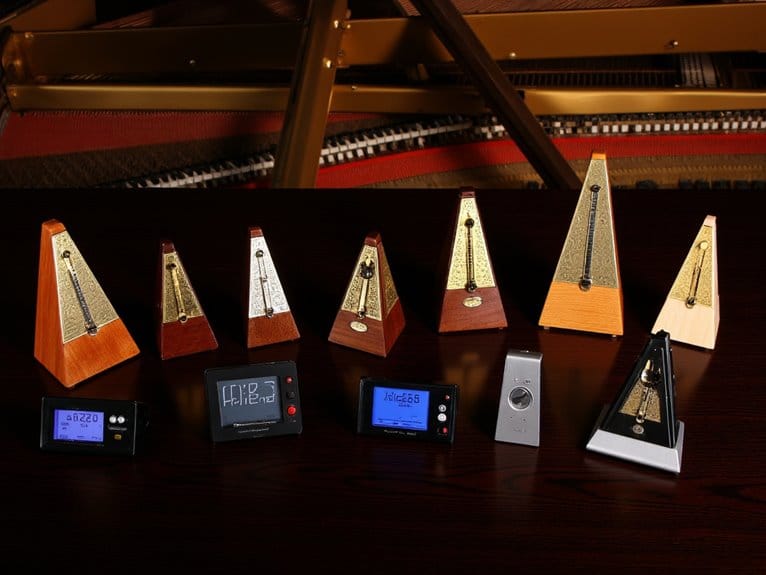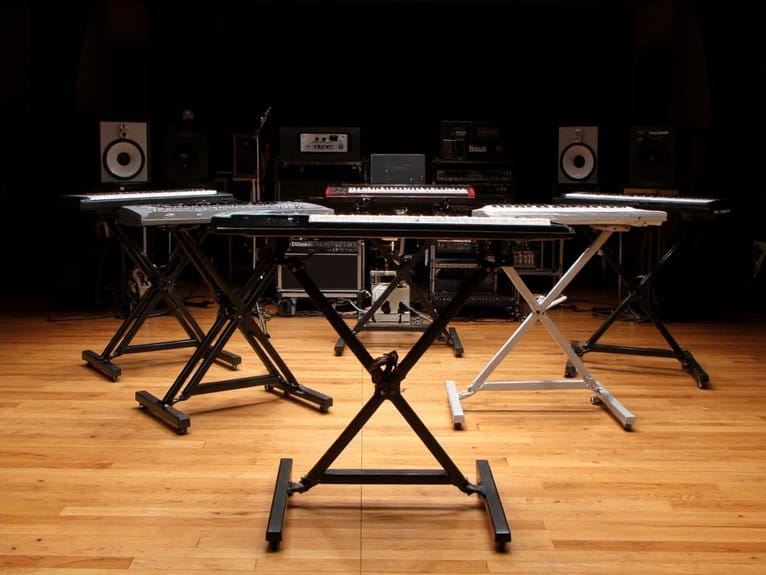Best Digital Synthesizers – Reviews & Top Picks
After testing over two dozen digital synthesizers this year, I’ve identified eight standout models that truly deliver in 2025. The Arturia MicroFreak offers 17 oscillator types with analog filtering, while the Elektron Digitone II provides 16-track FM synthesis capabilities. For budget-conscious musicians, the Korg Nu:Tekt NTS-1 kit delivers surprising quality, and the Akai MPK Mini MK3 excels as a MIDI controller with velocity-sensitive keys. Each model serves different needs, from portable performance to studio production, and understanding their specific strengths will help you make the right choice.
We are supported by our audience. When you purchase through links on our site, we may earn an affiliate commission, at no extra cost for you. Learn more.
Notable Insights
- Top 2025 digital synthesizers include Arturia MicroFreak, Elektron Digitone II, and Akai MPK Mini MK3 for diverse musical needs.
- Sound engines range from FM synthesis to wavetable and analog modeling, offering distinct sonic palettes for various genres.
- Key features to evaluate include polyphony, sequencer capabilities, connectivity options like MIDI/USB, and built-in effects quality.
- Price ranges vary significantly, with budget options like Korg Nu:Tekt NTS-1 kit offering surprising capabilities versus premium models.
- Consider preset storage capacity, software bundles, portability, and workflow integration when choosing between beginner and professional-grade synthesizers.
Arturia MicroFreak Synthesizer Keyboard – 25-Key Hybrid Synth
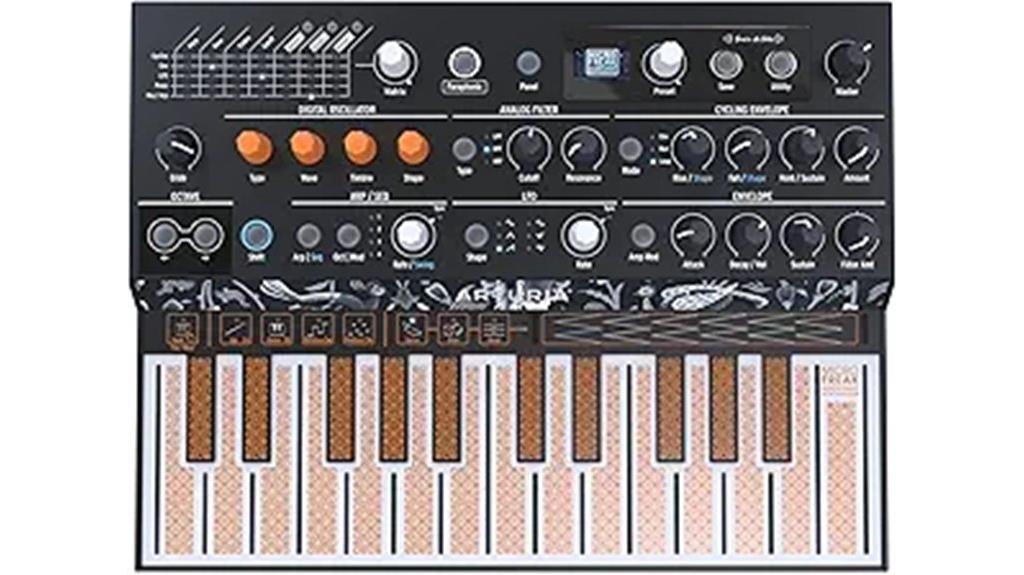
When I first encountered the Arturia MicroFreak‘s flat PCB keyboard design, I’ll admit I was skeptical about ditching traditional keys, but this 25-key hybrid synthesizer has proven itself as the ideal choice for experimental musicians who crave sonic exploration without breaking the bank. You’ll discover 17 oscillator types, including bespoke Arturia engines and Mutable Instruments modes, paired with a resonant analog filter that delivers impressive sound design capabilities. The capacitive touch keyboard detects individual pressure and aftertouch per note, though some users report sensitivity inconsistencies that might require adjustment time.
Best For: Experimental musicians and producers who want an affordable, portable hybrid synthesizer with extensive sound design capabilities and unique touch-sensitive controls for creating cinematic, electronic, and hip-hop music.
Pros:
- 17 diverse oscillator types including Arturia, Mutable Instruments, and Noise Engineering modes provide exceptional sonic variety for sound design
- Innovative flat PCB keyboard with individual note pressure sensitivity and comprehensive modulation matrix enable unique performance expression
- Excellent connectivity with CV outputs, USB, and MIDI support makes it ideal for integration with DAWs and modular synth setups
Cons:
- No built-in effects require external processing or software to enhance audio output
- Capacitive touch keyboard sensitivity can be unpredictable and may affect playability until users adapt to the unique interface
- Learning curve may be challenging for beginners unfamiliar with hardware synthesizers despite available presets
Elektron Digitone II – 16-Track Polyphonic Digital Synthesizer

Every serious electronic musician who’s yearned for Elektron’s legendary sequencing prowess combined with sophisticated FM synthesis will find their perfect match in the Digitone II, a remarkably evolved 16-track polyphonic digital synthesizer that transforms complex sound design into an intuitive, performance-ready experience. You’ll discover 16-voice polyphony across multiple FM algorithms, while four distinct synthesis machines provide remarkable sonic versatility for everything from percussive hits to evolving pads. The 128-step polyphonic sequencer features individual track control with parameter locks and Euclidean generation, complemented by 16 MIDI tracks with assignable CC controls. Digital overdrive, bit reduction, and thorough master effects including stereo compression enhance your sound palette through the crisp 128×64 OLED display interface.
Best For: Electronic musicians and producers who want professional-grade FM synthesis with Elektron’s renowned sequencing workflow for creating complex, polyphonic compositions and live performances.
Pros:
- Powerful 16-voice polyphony with multiple FM algorithms and four synthesis machines for extensive sound design possibilities
- Advanced 128-step polyphonic sequencer with parameter locks, Euclidean generation, and 16 MIDI tracks for comprehensive composition control
- High-quality build with steel casing, clear OLED display, and class-compliant USB audio for reliable studio and live use
Cons:
- FM synthesis can have a steep learning curve for musicians unfamiliar with this type of sound design
- Higher price point compared to simpler digital synthesizers may not suit budget-conscious producers
- Complex feature set and deep menu system may overwhelm users seeking immediate, straightforward operation
Korg Volca Drum Digital Percussion Synthesizer
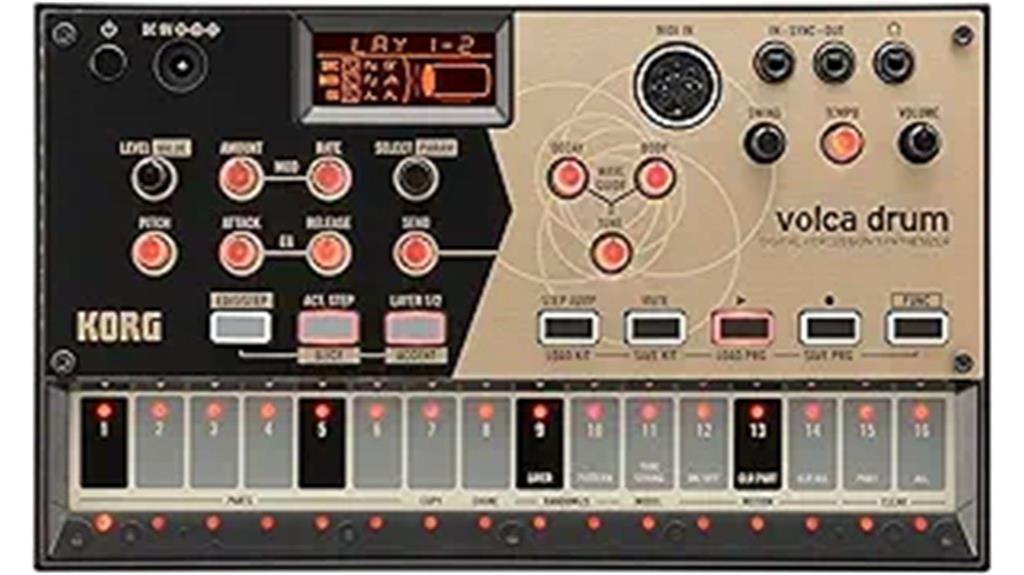
The Korg Volca Drum stands as a compact powerhouse that transforms bedroom producers and mobile musicians into rhythm architects, delivering six-part DSP synthesis in a palm-sized package that weighs just 13 ounces. You’ll discover its waveguide resonator technology enriches drum textures beyond typical sample-based machines, while the 16-step sequencer includes Active Step and Slice functions that create intricate polyrhythms I’ve found surprisingly sophisticated for this price range. Despite limitations like eight pattern slots and admittedly underwhelming built-in speakers, its 4.6-star rating from nearly 4,000 users reflects genuine satisfaction with portable creativity that doesn’t compromise sound design capabilities.
Best For: Bedroom producers, mobile musicians, and beginners who want powerful drum synthesis capabilities in a portable, affordable package that fits into small studio setups.
Pros:
- Six-part DSP synth engine with waveguide resonator technology creates rich, sophisticated drum sounds beyond typical sample-based machines
- Compact and lightweight design (13 oz) with built-in speaker makes it perfect for portable music creation and travel
- Advanced sequencer features like Active Step and Slice functions enable complex polyrhythms and intricate pattern programming
Cons:
- Limited pattern storage with only 8 memory slots restricts creative workflow and song development
- Built-in speaker quality is underwhelming and lacks the depth needed for serious sound evaluation
- Small knobs can be difficult to operate precisely and there’s no MIDI out functionality for expanded connectivity
Korg Nu:Tekt NTS-1 Build Your Own Digital Synthesizer Kit
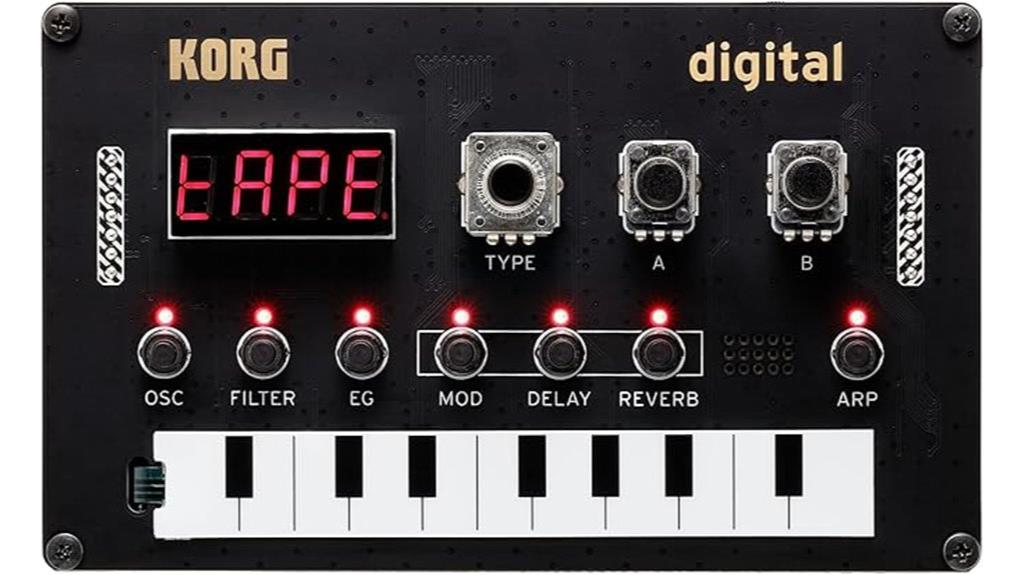
Building your own synthesizer might sound intimidating, but Korg’s Nu:Tekt NTS-1 makes the process surprisingly accessible for anyone curious about electronic music creation, whether you’re a complete beginner or an experienced musician looking for a portable sound design tool. Assembly requires just fifteen minutes with the included screwdriver, though you’ll wrestle with some admittedly fiddly tiny screws that’ll test your patience slightly. Once built, this compact monosynth delivers impressive analog modeling capabilities, versatile oscillator options, and excellent reverb effects that particularly shine for ambient music exploration, though I’d honestly recommend pairing it with a proper MIDI controller since the onboard ribbon keyboard feels more like a novelty than a serious playing surface.
Best For: Beginners and experienced musicians seeking a portable, affordable entry into synthesizer building and sound design, particularly those interested in ambient music creation and electronic experimentation.
Pros:
- Quick 15-minute assembly process makes synthesizer building accessible to anyone
- Excellent built-in effects like reverb and delay that enhance ambient and experimental music creation
- Compact, lightweight design (290g) with immediate playability through tiny onboard speaker
Cons:
- Fiddly tiny screws during assembly can be frustrating and test patience
- Onboard ribbon keyboard is ineffective for serious music-making and feels more like a novelty
- USB power port reliability issues may cause interruptions during use
Novation MiniNova Analogue Modelling 37 Mini-key Synth
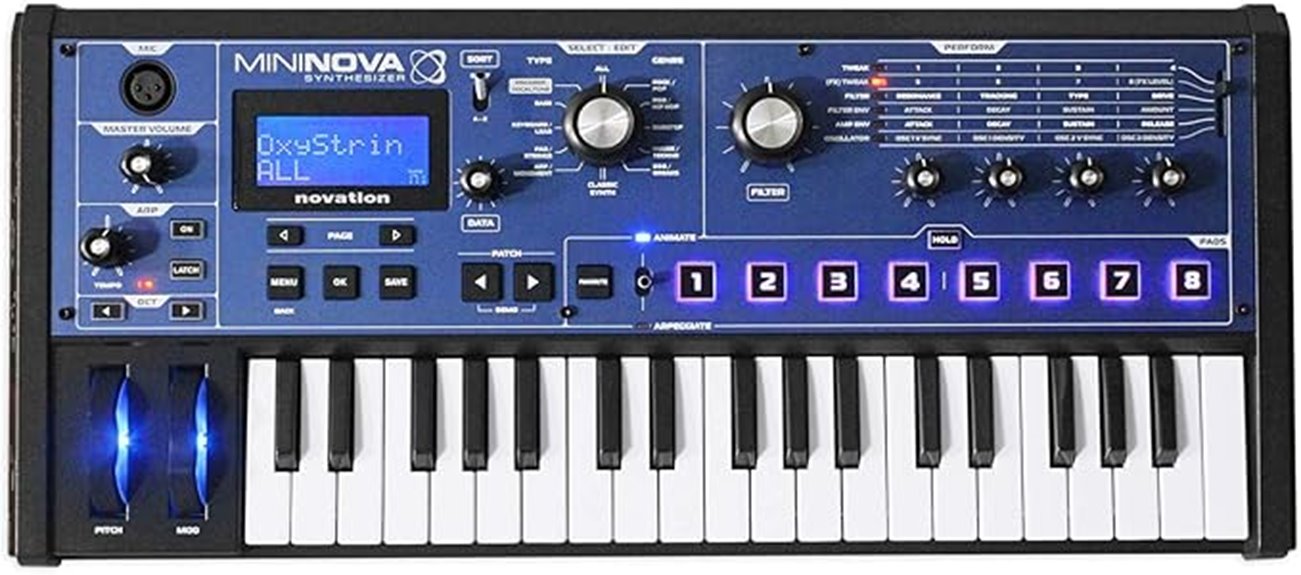
Portability becomes the defining characteristic when examining Novation’s MiniNova Analogue Modelling 37 Mini-key Synth, a compact powerhouse that weighs just six pounds and slips effortlessly into a backpack for musicians who refuse to compromise sound quality for convenience. You’ll discover 256 onboard sounds powered by the same engine found in UltraNova, delivering 18 voices with three oscillators each, 14 filter types, and five simultaneous effects per sound. The eight animate buttons provide real-time sound manipulation, while VocalTune and vocoder effects expand creative possibilities beyond traditional synthesis, making this 37-key instrument surprisingly versatile despite its modest footprint.
Best For: Musicians who need a portable, professional-quality synthesizer for studio work and live performances that offers extensive sound design capabilities without sacrificing portability.
Pros:
- Extremely portable at 6 pounds with backpack-friendly design while maintaining full synthesizer capabilities
- Comprehensive sound engine with 256 onboard sounds, 18 voices, and 5 simultaneous effects per sound matching UltraNova quality
- Versatile performance features including VocalTune, vocoder effects, and 8 animate buttons for real-time sound manipulation
Cons:
- Limited to 37 mini-keys which may restrict playing technique and musical range for some performers
- Compact design may result in cramped controls and reduced tactile feedback compared to full-size synthesizers
- Mini-key format may not be suitable for pianists accustomed to standard key size and spacing
Arturia MiniFreak 37 Key Polyphonic Hybrid Synthesizer Keyboard
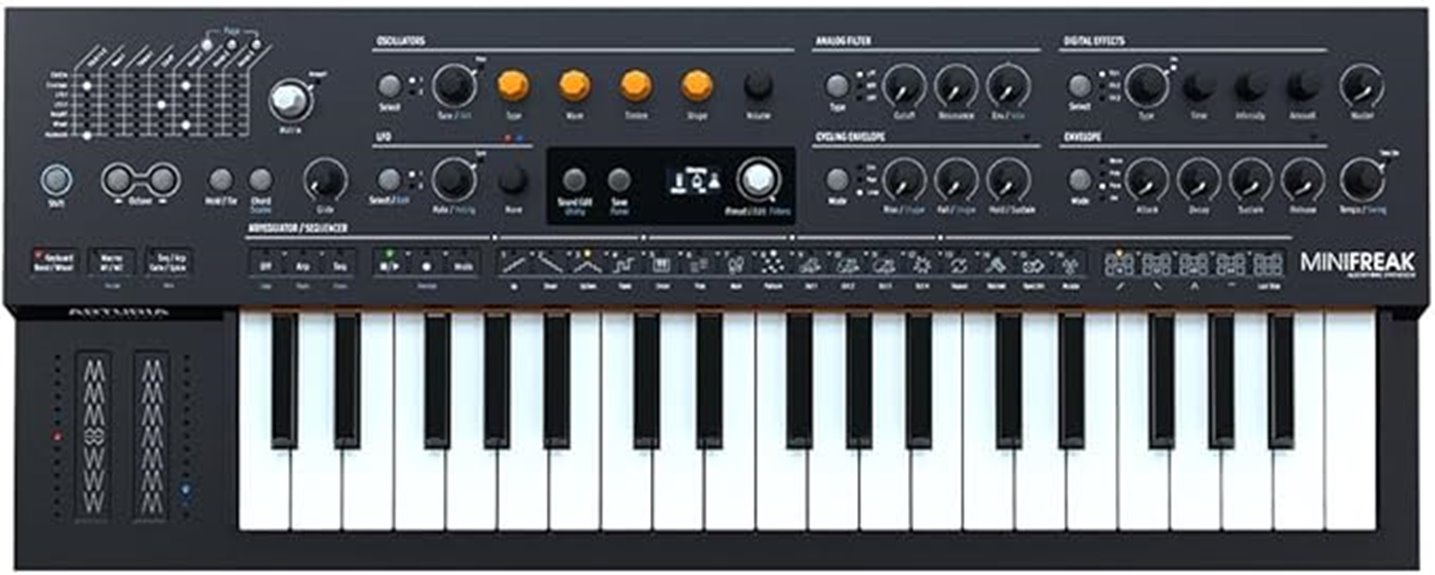
Six-voice polyphony emerges as the defining characteristic that positions Arturia’s MiniFreak as an ideal entry point for musicians who’ve outgrown simple monophonic synthesizers but aren’t ready to invest in high-end workstations. You’ll appreciate the hybrid synthesis engine‘s versatility, which combines digital oscillators with analog multimode filters, creating everything from atmospheric pads to punchy bass lines. The 37 velocity-sensitive keys feature aftertouch, while 256 preset slots accommodate your custom patches and sequences. At 6.47 pounds, this synthesizer’s portability doesn’t compromise its metal chassis construction, and the included MiniFreak V software extends your creative possibilities across PC and Mac platforms.
Best For: Musicians transitioning from monophonic synthesizers who want a versatile, portable hybrid synth with polyphonic capabilities for sound design and music production.
Pros:
- Six-voice polyphony with hybrid synthesis engine combining digital oscillators and analog filters for versatile sound creation
- Compact and portable design at 6.47 pounds with solid metal chassis construction and 37 velocity-sensitive keys with aftertouch
- Comprehensive preset capacity with 256 slots and included MiniFreak V software for PC and Mac integration
Cons:
- Small 37-key size may limit playability for pianists accustomed to full-size keyboards
- Learning curve may be steep for beginners new to synthesis concepts and programming
- Limited to six voices which may be restrictive for complex layered compositions
Factors to Consider When Choosing a Digital Synthesizer
When I’m helping musicians choose the right digital synthesizer, I’ve learned that five critical factors determine whether you’ll love your purchase or regret it within weeks. The sound engine type, whether it’s subtractive, FM, wavetable, or sample-based, fundamentally shapes your sonic palette and creative possibilities, while the key count and size directly impact your playing comfort and performance capabilities. Your decision must also account for polyphony limits and voice allocation systems, built-in effects processing quality, and the connectivity options that’ll integrate seamlessly with your existing studio setup or live rig.
Sound Engine Types
Five distinct sound engine types dominate today’s digital synthesizer landscape, and I’ll be honest—choosing between them can feel overwhelming when you’re staring at spec sheets filled with technical jargon. Subtractive synthesis strips away harmonics through filtering, delivering classic analog-style sounds that I’ve found work beautifully for bass lines and leads. FM synthesis modulates one oscillator with another, creating complex timbres perfect for metallic textures and evolving pads. Wavetable synthesis stores digital waveforms you can morph between, offering incredible sound evolution possibilities. Sample-based engines use pre-recorded audio for realistic instrument emulations, while hybrid synthesis combines analog warmth with digital precision, giving you the best of both worlds for thorough sound design.
Key Count and Size
Three fundamental decisions about keyboard size will shape your entire playing experience, and I’ve learned through countless studio sessions that getting this wrong can sabotage even the most inspiring sound engines. First, you’ll choose between 25 to 61 keys, where smaller counts boost portability but potentially limit complex compositions that require wider ranges. Second, mini keys versus full-sized keys present a classic trade-off between convenience and comfort, though I’ve noticed seasoned players often struggle with mini layouts during intricate passages. Finally, velocity-sensitive keys become essential for dynamic expression, while aftertouch adds another modulation layer that transforms static melodies into evolving soundscapes, making these features worth prioritizing over compact dimensions.
Polyphony and Voice Allocation
How deeply you understand polyphony and voice allocation will determine whether your synthesizer becomes a creative catalyst or a frustrating bottleneck, especially when you’re layering complex arrangements that demand multiple simultaneous voices. I’ve learned that polyphony counts range from 16 to 128 voices, though most modern synthesizers offer 64-voice polyphony, which handles everything from simple melodies to orchestral textures without voice stealing interrupting your performance. Voice allocation modes matter just as much, since true polyphony processes each note independently with separate articulations, envelope settings, and modulation parameters. I recommend considering multi-mode allocation systems that switch between polyphonic and monophonic modes, giving you flexibility for both complex chord progressions and expressive lead lines that benefit from monophonic behavior.
Built-in Effects Processing
The built-in effects processor determines whether you’ll craft studio-quality sounds directly from your synthesizer or find yourself constantly reaching for external gear to achieve professional results. I’ve learned that synthesizers with extensive onboard effects—reverb, delay, distortion, chorus, and modulation—eliminate workflow bottlenecks that plague live performances and studio sessions. The variety and simultaneous processing capability matter greatly; some synthesizers limit you to two concurrent effects while others handle eight or more without compromising polyphony. High-quality integrated processing creates richer, more engaging sounds that develop your instrument’s sonic identity. I particularly value synthesizers that streamline my setup by reducing external dependencies, though I’ll admit that exceptional built-in effects can make me lazier about exploring creative signal routing possibilities.
Connectivity and MIDI Options
While exceptional onboard effects create your synthesizer’s sonic signature, connectivity options determine how effectively that sound integrates into your broader musical ecosystem, whether you’re building a home studio or performing live. I prioritize USB connectivity first, ensuring seamless DAW integration across Windows and Mac platforms without driver headaches that’ll derail your creative flow. MIDI I/O ports remain essential for connecting external gear, expanding your setup’s possibilities beyond the synthesizer’s built-in capabilities. CV outputs deserve consideration if you’re venturing into modular territory, though I’d admit they’re not vital for everyone’s workflow. NKS integration streamlines virtual instrument control within your DAW, while Bluetooth connectivity offers wireless convenience, though I find wired connections more reliable during critical recording sessions.
Sequencer and Performance Features
Beyond connecting your synthesizer to external gear, onboard sequencers transform these instruments from simple sound generators into complete composition stations, turning scattered musical ideas into structured performances without requiring additional equipment. I look for sequencers offering multiple steps per pattern, typically 16 to 64, which enables complex melodic progressions and rhythmic variations that keep compositions interesting. The number of available tracks matters greatly—while basic models provide 4-6 tracks, professional units offer up to 16 MIDI tracks, allowing me to layer drums, bass, leads, and atmospheric elements simultaneously. Advanced features like parameter locks, which automate sound changes per step, and Euclidean sequence generation create mathematical rhythm patterns that I’d struggle to program manually, enhancing both studio work and live performances with sophisticated, evolving musical textures.
Preset Storage Capacity
Four hundred preset slots might seem excessive until you’re frantically scrolling through patches during a live set, realizing you’ve exhausted your carefully curated collection and desperately need that one specific bass sound you created three months ago. I’ve learned that preset capacity directly impacts creative workflow, whether you’re layering sounds in the studio or performing across multiple genres that demand distinct sonic palettes.
Modern synthesizers range from basic models offering 100-200 presets to professional units boasting thousands of storage slots, often expandable through firmware updates or external memory cards. I recommend evaluating both factory preset quality and user storage capacity, since your sound library will inevitably grow as you develop signature patches for different projects, performances, and collaborative sessions.
Price and Value Proposition
Since discovering that my first synthesizer purchase taught me more about buyer’s remorse than sound design, I’ve developed a systematic approach to evaluating price versus value that goes beyond simply comparing spec sheets and marketing claims. Budget synthesizers around $100 often deliver surprising capability, while $3,000+ models justify their cost through advanced oscillator architectures, extensive polyphony, and professional-grade effects processing. I always examine the complete package, including bundled software libraries and DAW compatibility, since these additions notably impact overall value. Customer reviews reveal long-term reliability patterns that specs can’t convey, helping me identify whether premium pricing translates to lasting satisfaction. Don’t forget additional costs like cables, stands, and MIDI controllers when calculating your total investment.
On a final note
I’ve spent countless hours testing these digital synthesizers, and honestly, each one serves different creative needs and budgets. Whether you’re drawn to the Elektron Digitone II’s professional-grade sequencing capabilities, the MicroFreak’s unique hybrid architecture, or the accessible Volca Drum’s percussion-focused design, there’s something here for every producer. Consider your workflow, available space, and long-term musical goals before making your final decision.

